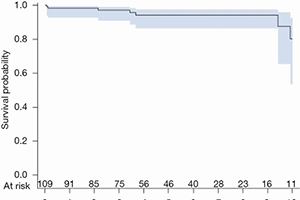Long-term outcomes of etiology specific annuloplasty ring repair of ischemic mitral regurgitation
Abstract
Background: Reductive annuloplasty repair of ischemic mitral regurgitation (IMR) is associated with high rates of recurrent MR, which may be improved with etiology-specific annuloplasty rings.
Methods: From October 2005 to May 2015, 128 consecutive patients underwent repair of IMR with the GeoForm ring. Clinical data was extracted from our local Society of Thoracic Surgeons database and electronic medical records. Mortality data was obtained from the Michigan State Social Security Death Index.
Results: The average age of patients was 65±11 years with mean pre-op left ventricular ejection fraction (LVEF) of 30%±10% and MR grade of 3.1±0.9 (0–4+). Thirty-day mortality was 4.7%, rate of renal failure 7.9%, rate of atrial fibrillation 27.3%, and no strokes were observed. Of the surviving patients, 89% (109/122) had a follow-up echocardiogram beyond 1 month with a mean echocardiographic follow-up of 59±39 months. LVEF improved from 30%±10% to 38%±14%, P<0.001) while end-diastolic (5.9±0.0 to 5.3±0.9 cm, P<0.001) and end-systolic (5.0±1.0 to 4.4±1.1 cm, P<0.001) left ventricular (LV) diameters decreased, as compared to pre-operative values. Seven patients were found to have recurrent moderate or greater IMR in follow-up to 10 years with three being due to ring dehiscence. One-, 5-, and 10-year freedom from recurrent moderate or severe IMR was 98%, 94%, and 80% respectively. One-, 5-, and 10-year
survival was 91%, 77%, and 44%, respectively.
Conclusions: Overall, etiology-specific ring repair of IMR was associated with low rates of recurrent MR on long-term follow-up, coupled with significant LV reverse remodeling and improvement in ejection fraction.
Cover






